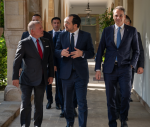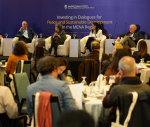You are here
How to organise reconstruction aid for post-war Ukraine
Aug 02,2022 - Last updated at Aug 02,2022
By Yuriy Gorodnichenko, Anastassia Fedyk, and Ilona Sologoub
BERKELEY — Earlier last month, high-level representatives from over 40 countries gathered in Lugano, Switzerland, and pledged support for ambitious plans to reconstruct Ukraine. The Ukraine Recovery Conference was an important milestone in preparing for the reconstruction of Ukraine, indicating that significant resources may be invested in the country after the war. But the conference did not shed much light on key issues. How will reconstruction be organised, and who will control and direct the money?
These are difficult questions that require thorough consideration, and they should be addressed before significant funds are committed to Ukraine’s recovery. An optimal design would reflect the importance of several factors.
For starters, it is necessary to determine how centralised or decentralised the reconstruction will be. One extreme is Gosplan, the Soviet agency that dictated the minutest details of production. Although the Soviet Union’s centrally planned economy failed in the long run, central planning can mobilise resources in the short run. But this short-term gain comes at a high cost, the Soviet economy was plagued with inefficiencies.
At the other extreme is complete decentralisation with individual commitments. For example, Hamburg recently committed to provide Kyiv with humanitarian aid. This approach can be instrumental in increasing Ukraine’s local “ownership” of the reconstruction: Because Kyiv requested aid, it will be more likely to take good care of it. On the other hand, decentralisation can lead to duplication of effort and lack of coordination.
A related approach is to centre reconstruction on projects akin to those that development banks undertake in emerging economies. This is a useful model for addressing targeted needs, for example, a lack of electricity in a particular region. But it is less well-suited for the reconstruction of countries. The failed reconstruction programmes in Afghanistan and Iraq after 2003 suggest that it is absolutely imperative for donors and recipients to coordinate on projects.
The horizon for recovery should also be identified. This process can take years, so multiyear planning is critical. The Marshall Plan for Europe after World War II, which was designed this way and lasted four years, is often credited with creating the foundations for Europe’s rapid growth during the post-war period. But it did not begin until three years after the war ended. At the same time, the newly created United Nations also provided significant assistance to Europe. Unlike the Marshall Plan, however, UN programmes were so plagued by uncertainty regarding their anticipated duration that European governments could not rely on them to continue from one year to the next.
Ukraine’s experience as a recipient of financial aid to support the current war effort illustrates the risks. And once the immediate pressure to deal with Russia is relieved, politicians in Ukraine and the West may change their priorities. To insulate reconstruction from such vagaries, it should be organised by a stable, technocratic organisation that can oversee its planning and execution and stay relatively immune from the hurly-burly of political life.
Ukraine’s new status as a European Union candidate country should help here. We believe that reconstruction and accession should be joint processes. Ukraine’s reconstruction is not only about rebuilding physical infrastructure, but also about deep modernisation of institutions and social infrastructure. Its aspiration to join the EU is a powerful catalyst and should help to overcome vested interests.
This is important, given the country’s checkered history of reforms: Since independence in 1991, Ukraine has completed only one International Monetary Fund programme. The other ten or so were stopped after Ukraine failed to deliver on its promises. A large share of Ukraine’s future economic growth will come from foreign direct investment, and inflows will depend on adherence to the rule of law and other EU standards.
Internal and external transparency will be crucial to the success of the reconstruction process. Since much of the funding will come from the EU, European taxpayers have every right to know how their money is spent. This will have to be a joint project: As much as Ukraine must own the reconstruction, the EU must co-own it. Again, the experience of Afghanistan and Iraq suggests that when donors have little ownership in the reconstruction process, through joint decision making, local sourcing, and community input, their lack of commitment can lead to disastrous consequences.
The EU’s most valuable role for Ukraine will be to provide an institutional anchor. Vast budgets will have to be carefully and transparently planned, administered, reported, and audited. While Ukraine has made huge progress in rooting out corruption since the Revolution of Dignity in 2014, much work remains to be done. For example, the National Anti-Corruption Bureau and the Specialised Anti-Corruption Prosecutor’s Office have been headless for 18 months and the National Anti-Corruption Bureau has not had a chief since April 2022, limiting the effectiveness of these bodies. Through its institutional capacity and conditionality of aid, the EU can help Ukraine ensure that reconstruction will not be another giveaway to the “right people”, as was the case during the privatisations of the 1990s.
The Economic Cooperation Administration, the US agency created to oversee the Marshall Plan, comes closest to satisfying these criteria. The ECA was a largely technocratic institution with a multiyear planning horizon. It coordinated closely with local governments to avoid duplication and waste, but local governments formulated requests for funding, thereby owning the reconstruction process. When necessary, the ECA enforced conditionality to ensure that countries ravaged by the war kept their promises to reform. The ECA embodied the American commitment to rebuild Western Europe, and those who managed it felt responsible for achieving this goal.
We have learned a lot since then, of course, and the ECA prototype can certainly be refined. But it provides the model Ukraine and its partners should use as they start planning the country’s reconstruction.
Yuriy Gorodnichenko is professor of economics at the University of California, Berkeley. Anastassia Fedyk is assistant professor of finance at the University of California, Berkeley. Ilona Sologoub, editor of VoxUkraine, is director of Political and Economic Research at Kyiv School of Economics. Copyright: Project Syndicate, 2022. www.project-syndicate.org












